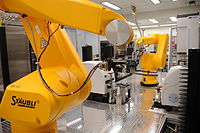
Photo from wikipedia
Single molecule RNA imaging using fluorescent in situ hybridization (FISH) can provide quantitative information on mRNA abundance and localization in a single cell. There is now a growing interest in… Click to show full abstract
Single molecule RNA imaging using fluorescent in situ hybridization (FISH) can provide quantitative information on mRNA abundance and localization in a single cell. There is now a growing interest in screening for modifiers of RNA abundance and/or localization. For instance, microsatellite expansion within RNA can lead to toxic gain-of-function via mislocalization of these transcripts into RNA aggregate and sequestration of RNA-binding proteins. Screening for inhibitors of these RNA aggregate can be performed by high-throughput RNA FISH. Here we describe detailed methods to perform single molecule RNA FISH in multiwell plates for high-content screening (HCS) microscopy. We include protocols adapted for HCS with either standard RNA FISH with fluorescent oligonucleotide probes or the recent single molecule inexpensive FISH (smiFISH). Recommendations for success in HCS microscopy with high magnification objectives are discussed.
Journal Title: Methods
Year Published: 2017
Link to full text (if available)
Share on Social Media: Sign Up to like & get
recommendations!